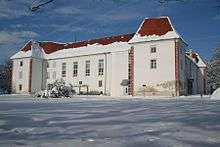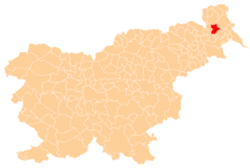Murska Sobota
Murska Sobota (pronounced [ˈmúːɾska ˈsóːbɔta] (![]()
Murska Sobota | |
|---|---|
City | |
 City of Murska Sobota | |
 Flag  Coat of arms | |
 Murska Sobota Location of the city of Murska Sobota in Slovenia | |
| Coordinates: 46°40′N 16°10′E | |
| Country | |
| Traditional region | Prekmurje |
| Statistical region | Mura |
| Municipality | Murska Sobota |
| First mention | 1297 (as Belmura) |
| Town rights | around 1479 |
| Government | |
| • Mayor | Aleksander Jevšek (SD) |
| Area | |
| • Total | 14.5 km2 (5.6 sq mi) |
| Elevation | 190 m (620 ft) |
| Population (2020) | |
| • Total | 11,107 |
| • Density | 770/km2 (2,000/sq mi) |
| Time zone | UTC+01 (CET) |
| • Summer (DST) | UTC+02 (CEST) |
| Post code | 9000 |
| Area Code | +382 02 |
| Website | www |
Name

Officially, the city is known as Murska Sobota, although informally it is usually simply referred to as Sobota by its inhabitants and Murska by people from other parts of Slovenia. The settlement was first attested in written documents in 1297 as Belmura (and as Murazombatha in 1348 and Murazumbota in 1366).[3] The traditional German name of the city is Olsnitz, which is derived from the old Slovene name Olšnica. The modern Slovene name is a translation of the Hungarian name Muraszombat, which was the official name of the city until 1919. In Hungarian, szombat means 'Saturday', referring to the city's practice of holding fairs every week on that day. Murska Sobota was a district (Hungarian: járás) city of Vas County in the Kingdom of Hungary until 1918. It was occupied by Hungary again during World War II, from 1941 to 1944. Between 1944 and 1945 it was under Nazi German occupation and it was liberated by Soviet troops in May 1945. It was also part of the Balatin Sanjak, which belonged at first to the Budin Eyalet, later the Kanije Eyaleti, before the Treaty of Karlowitz.
History
Murska Sobota used to be Yugoslavia's northernmost city, and throughout history it has shifted across borders between Slovenia, Yugoslavia, and Hungary. Hungarians still represent a 3,000-person minority. In 1919, the Republic of Prekmurje was declared here and the city was the capital of the new state. In 1991, during the Ten-Day War between Slovenia and the Yugoslav Federal Army, Murska Sobota was bombed from the air, with no casualties or visible damage. Today, it is a quiet city with an economy based on regional administration, light industry, commerce, and spa tourism. In April 2006, the city became the see of the newly created Roman Catholic Diocese of Murska Sobota, which is a suffragan to the archdiocese of Maribor.
Jewish community of Murska Sobota
The once significant Jewish community of Murska Sobota was eliminated by Nazi Germany. Before the World War II, a synagogue built by Lipót Baumhorn stood in Murska Sobota. It was consecrated on 31 August 1908 and demolished in 1954 by the local communist authorities after they purchased the building from a decimated Jewish community. The last rabbi in Murska Sobota was Lazar Roth.[4] He was murdered at Auschwitz.
On 26 April 1944, all of the Jews were ordered to gather in the Murska Sobota synagogue, with hand luggage only. There, they were locked up overnight without food or water, and the next morning all the Jews of Murska Sobota were transferred to Čakovec and then to Nagykanizsa, the main concentration camp before their final destination of Auschwitz.[5]
On 29 January 2010, the first Holocaust memorial in Slovenia was unveiled at the Murska Sobota railway station. It is dedicated to the exile of Jews from the Prekmurje region.[6][7]
Climate
Annual rainfall in Murska Sobota is among the lowest in Slovenia. Characterized by the instability of rainfall, severe droughts are frequent.
| Climate data for Murska Sobota | |||||||||||||
|---|---|---|---|---|---|---|---|---|---|---|---|---|---|
| Month | Jan | Feb | Mar | Apr | May | Jun | Jul | Aug | Sep | Oct | Nov | Dec | Year |
| Record high °C (°F) | 16.4 (61.5) |
21.7 (71.1) |
25.6 (78.1) |
27.9 (82.2) |
31.4 (88.5) |
35.0 (95.0) |
35.6 (96.1) |
37.9 (100.2) |
30.6 (87.1) |
27.9 (82.2) |
21.9 (71.4) |
19.8 (67.6) |
37.9 (100.2) |
| Average high °C (°F) | 2.5 (36.5) |
5.8 (42.4) |
11.0 (51.8) |
15.6 (60.1) |
20.8 (69.4) |
23.7 (74.7) |
25.9 (78.6) |
25.6 (78.1) |
21.2 (70.2) |
15.2 (59.4) |
8.0 (46.4) |
3.5 (38.3) |
14.9 (58.8) |
| Daily mean °C (°F) | −1.2 (29.8) |
0.9 (33.6) |
5.3 (41.5) |
9.8 (49.6) |
15.0 (59.0) |
18.0 (64.4) |
19.7 (67.5) |
19.0 (66.2) |
14.8 (58.6) |
9.4 (48.9) |
3.9 (39.0) |
0.0 (32.0) |
9.6 (49.3) |
| Average low °C (°F) | −4.9 (23.2) |
−3.4 (25.9) |
0.1 (32.2) |
3.9 (39.0) |
8.6 (47.5) |
11.9 (53.4) |
13.5 (56.3) |
13.0 (55.4) |
9.4 (48.9) |
4.7 (40.5) |
0.3 (32.5) |
−3.1 (26.4) |
4.5 (40.1) |
| Record low °C (°F) | −26.9 (−16.4) |
−26.4 (−15.5) |
−18.0 (−0.4) |
−5.8 (21.6) |
−4.2 (24.4) |
−0.1 (31.8) |
5.1 (41.2) |
2.1 (35.8) |
−3.5 (25.7) |
−8.6 (16.5) |
−16.6 (2.1) |
−22.4 (−8.3) |
−26.9 (−16.4) |
| Average precipitation mm (inches) | 31 (1.2) |
36 (1.4) |
47 (1.9) |
55 (2.2) |
72 (2.8) |
104 (4.1) |
97 (3.8) |
93 (3.7) |
81 (3.2) |
71 (2.8) |
70 (2.8) |
48 (1.9) |
805 (31.7) |
| Average precipitation days (≥ 0.1 mm) | 8.9 | 8.2 | 10.3 | 11.9 | 12.6 | 14.4 | 12.3 | 11.4 | 10.3 | 10.2 | 10.7 | 10.6 | 131.9 |
| Mean monthly sunshine hours | 65 | 103 | 148 | 177 | 233 | 236 | 265 | 253 | 182 | 130 | 72 | 57 | 1,913 |
| Source: Slovenian Enivironment Agency (ARSO), sunshine hours are for: Murska Sobota 1971-2000 [8] (data for 1971-2000) | |||||||||||||
International relations
Twin towns – Sister cities
Murska Sobota is twinned with:






References
- "Slovenski pravopis 2001: Murska Sobota".
- Radkersburg und Luttenberg (map, 1:75,000). 1894. Vienna: K.u.k. Militärgeographisches Institut.
- Snoj, Marko (2009). Etimološki slovar slovenskih zemljepisnih imen. Ljubljana: Modrijan. p. 276.
- History of the Jews in Murska Sobota
- Jews of Murska Sobota
- "Memorial to Exiled Jews Unveiled in Murska Sobota". STA. 29 January 2010.
- "A memorial dedicated to the exile of Jews from the NE region of Prekmurje is unveiled at the Murska Sobota train station". STA. 29 January 2010. Archived from the original on 21 July 2011.
- "Murska Sobota Climate normals 1971-2000" (PDF). ARSO. Retrieved 17 September 2015.
External links
| Wikimedia Commons has media related to Murska Sobota. |
